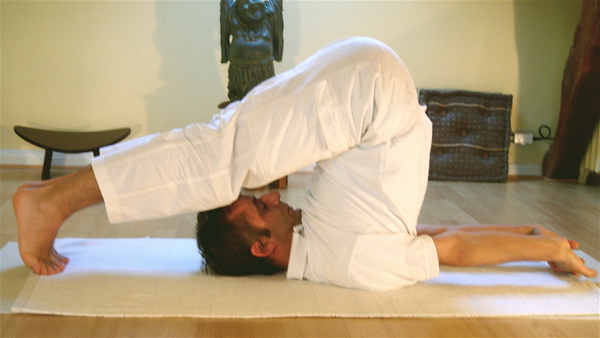I stopped doing all inverted yoga postures a couple years ago. The plow (plough, halasana) posture used to be one of my favorites. When I first started self-tonometry some years ago I did the plow posture for just a few minutes, then sat up and took some intraocular pressure measurements. My intraocular pressure after the plow was significantly elevated compared to before the posture and the elevated pressure was high enough to be a concern (above 30). That was the last time I did any inverted yoga postures -- until just a couple days ago.

With the excellent results I'm getting from Serene Impulse(especially while lying in bed/sleeping), I got brave. I decided to see what would happen to my eye pressure with the plow posture.
And now that I have the iCare tonometer, I can test things like this more accurately. I do not have to stand up, walk to the tonometer, sit down and wait while the tonometer measures my eye pressure. With the iCare, I can remain lying on the floor and take an intraocular pressure measurement very quickly. I get measurements within seconds rather than minutes.
I cannot yet actually do self-tonometry in an inverted yoga posture, but I can do it within seconds of transitioning to a supine position. This is much, much better than my original testing situation. I should see higher values when testing in the supine position with this new testing procedure because IOP will drop as soon as one sits up and it will usually drop even more by the time one stands up and walks even a few steps.
I did a first brief test of the yoga plow posture a couple days ago. I stayed inverted for only about 2 minutes. Afterwards my IOP was 13 mmHg. (Each IOP test was the average of 6 individual readings with the iCare tonometer.)
I tested a few more times over the next few days and each time my eye pressure remained in a very good range after the inverted yoga postures.
Today I did a brutal test of a long series of inverted yoga postures that I was sure would elevate my intraocular pressure further. It did elevate my IOP all the way up to 18 mmHg. However, this is a far cry from the IOP values in the 30's that I used to see after inverted yoga postures. (And those old values in the 30's were less than the true peak because I had to sit up to take a measurement, as mentioned above.) Many normal people (non glaucoma patients) will see intraocular pressure values at 18 mmHg or higher after inverted yoga postures. I was extremely pleased with the results of todays tests. I know that my anticipated approach to inverted yoga postures will not elevate my IOP as much as this extreme test, so I should be well within the safe IOP zone.
Going forward, I believe I can resume limited amounts of inverted yoga postures on a regular basis. (My body will be happy about that!) My plan is to limit the inverted time and the postures I perform to things I can do without my IOP going above about 15 mmHg.
Here's one tip: I have found that if I do Serene Impulse followed by moderate exercise followed by yoga, the eye pressure elevation of inverted yoga postures is very, very mild. Based upon my tests so far, I can easily keep my IOP under my target after doing the plow posture if I take this approach.
I am reporting this for educational purposes only. My own curiosity motivated me to do the tests. I also feel I need to do more yoga to regain the flexibility I have lost since I stopped doing it. But I am not advising any glaucoma patients to start or resume inverted yoga postures. In short, my disclaimer is: "don't try this at home" unless you can take the same safety precautions I am taking.
Filed Under (tags):
- dave's blog
- Log in or register to post comments

